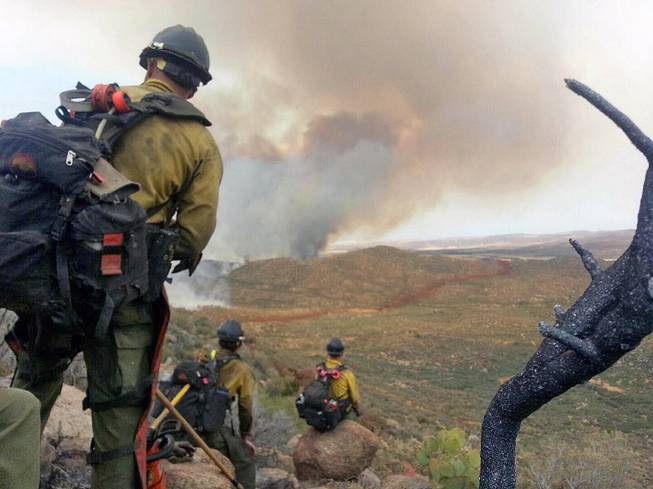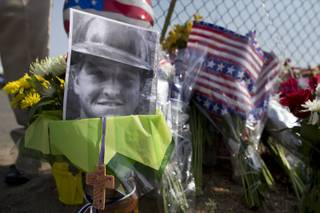
AP Photo / Courtesy of Juliann Ashcraft
In this photo shot by firefighter Andrew Ashcraft, members of the Granite Mountain Hotshots watch a growing wildfire that later swept over and killed the crew of 19 firefighters near Yarnell, Ariz., Sunday, June 30, 2013. Ashcraft texted the photo to his wife, Juliann, but died later that day battling the out-of-control blaze.
Friday, July 5, 2013 | 2 a.m.
Related story
There are a few experiences a Hotshot firefighter never forgets, because of the impact they leave on your senses and emotions. That's the case no matter how many years pass.
Like the smell of burning dirt, the way it coats your throat and instantly waters your eyes. Although it’s a common tactic to smother fire by throwing dirt on it, the dusty and dried-out ground of parched Southwestern forests smolders with acrid fumes when it’s shoveled onto flames.
Or the way the sun shines orange and perfectly round behind a thick overhang of smoke.
Or the sad sight of a beaver pond after it’s been fatally choked with ash and soot.
Seasonal and risky though the work may be, the life of a Hotshot opens doors to sights, sounds and adventures a person might not encounter any other way. As such, it attracts and captivates a certain type of person.
It’s a job that can provide a tour of some of the American West’s most beautiful and expansive forests — although they are far from pretty places once flames have worked them over.
It’s also a job that can lead to personal development, forcing one to build additional muscle and stamina, compelling a grasp of basic survival techniques and inspiring a working knowledge in first aid, tree identification and, of course, the use of chain saws.
The money can fund a college education, as in my case. And the experience can help toughen and mature a person, in much the same way that a stint in the military does for other young people trying to figure out life.
For six hot fire seasons, I was a member of the United States Forest Service’s Inter-regional Hotshots. Based in a spartan camp in the mountains near McCall, Idaho, we had our own assigned pair of World War II Douglas DC-3 airplanes, which regularly carried us to fires in faraway places, often in low-altitude and bumpy flights that were their own test of endurance.
It was a time when there were barely a dozen specialized Hotshot crews serving the entire West, and when such states as Nevada, Utah and Arizona had no such crews of their own. Because our team had trained in steep and heavily forested mountains, we were often assigned to complicated fires in the Western states. Just as now, they were almost always a result of lightning, errant campfires or fireworks. They usually burned in remote locations, with access more often than not requiring steep climbs and miles-long hikes with full backpacks and gear.
There are a lot more Hotshot crews these days, but the basic duties are the same today as they were then: stay in good physical shape and keep your saws tuned and sharp.
And, of course, prepare for anything at any time of day or night.
For example, because of soaring daytime temperatures, Hotshots often do their work after the sun has gone down, when mountain downdrafts help suppress flames. Headlamps are crucial in such work, but they don’t always illuminate patches of burning poison ivy or oak, fumes you never want to inhale. And it can be difficult to spot a wasps’ nest in the dark of night — at least until you’ve already started cutting into the tree harboring it.
Plus, each locale has its own ecosystem, with its own life forms agitated by smoke and trying to move out of the fire’s path. I probably would try to avoid killing a snake these days, but I still have a 38-inch rattler’s skin that is a framed reminder of one fireside encounter. We grilled its meat on a shovel over a burning log, in part because that’s the sort of thing that Hotshots do, but also because we were tired of the military rations, because that’s the sort of food Hotshots eat.
Technology has evolved, but the shovel remains a tool of the trade, as does the Pulaski — a firefighting tool with an axe on one side of its head and a trowel-shaped digging piece on the other. Both are used in the construction of fire lines or to remove fuel from a fire’s path.
Two other pieces of equipment also are standard, but fall into a different category: The canteens and portable fire shelters assigned to firefighters are both intended only for personal survival.
The canteen is a valued companion, especially in Southwestern regions known for soaring temperatures and where there’s rarely enough water to go around, either for dumping on flames or simply slaking a thirst.
The fire shelters, on the other hand, are rarely in use. Carried by wild-land firefighters for half a century now, they are essentially small tents deployed only when one is trapped by flames. And though they’ve improved the materials over the years, the concept is always the same: They are intended to reflect heat, and not built to withstand direct exposure to flames. Using one is a last resort, when there are no other options. No firefighter ever wants to be in the position of relying on one for survival.
But still you carry them, especially when you’re fighting fires in the incendiary Southwest.
Always so very dry in the summer, Arizona has particularly fast-growing fires, like the one that took the lives of 19 Granite Mountain Hotshots on June 30. It was a stunning loss of humanity, an unbelievable tragedy, and a shocking event even for the risky world of firefighting. For days now, both in the news and on social media, it’s something that current and former firefighters everywhere are still trying to explain and understand.
It’s true that firefighting can provide a good living and lead to unprecedented adventures; it also forged a lifelong camaraderie with my former crewmates, those of us united by shared experiences, some of them probably dangerous.
It almost certainly provided similar emotions and experiences to the 19 Granite Mountain Hotshots, who were undoubtedly bonded in life as well as in death.
But fire will always scale a forested mountain faster than any human can, often leaving so little alive in its wake. Such is the sobering common paradox of fire for humans, animals and trees alike: how it can so suddenly create such heart-wrenching tragedy and devastation in settings otherwise cherished as places of beauty and happiness.
Bruce Spotleson is general manager of KTUD-TV, an affiliate of Greenspun Media Group. The Las Vegas Sun and lasvegassun.com also are owned by GMG.




Join the Discussion:
Check this out for a full explanation of our conversion to the LiveFyre commenting system and instructions on how to sign up for an account.
Full comments policy